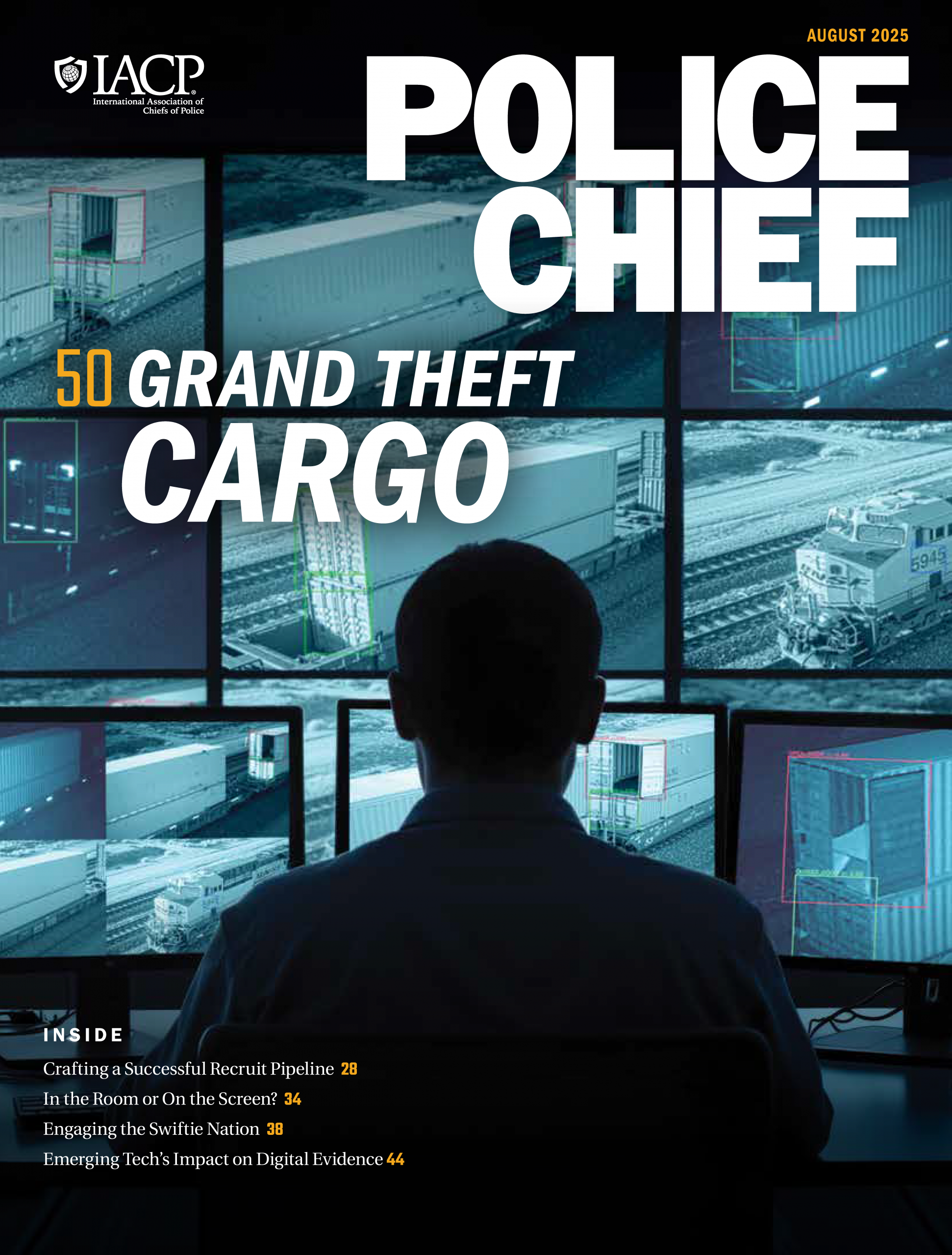One afternoon, the loss prevention associates of a local grocery store noticed a 17-year-old juvenile take food from the shelves and place the items into her backpack. An associate notified officers of the potential theft as they tracked the individual through the store surveillance cameras. The young female was approached by a loss prevention associate and appeared compliant until the local police arrived on scene. As the officers neared, the subject became combative. She began to flee the store on foot.
The next morning, a dispatcher notified police officers of a call from an elderly woman. She called 911 claiming that her son was having a mental health crisis and acting irrationally. The mother feared he was a danger to her and himself. When officers arrived on scene, they see the described individual standing on the porch with a knife declaring that he will kill anyone who comes near.
In both scenarios, officers must assess and decide which tool in their belts is the correct one to use in order to defuse the situation. From officer presence, verbal communications, and hands-on techniques to pain-inducing methods and lethal options, many officers are trained to use the minimum amount of force necessary to achieve their objectives. They are, however, also trained to prioritize the safety and well-being of all involved—themselves, the subject, and bystanders. For the above situations, officers may determine that a less-lethal tool is an appropriate use of force, and there are a variety of options within that category that they could use to maintain control.
Less-Lethal Alternatives
From pepper spray to batons to electronic control devices, there are many less-lethal alternatives to firearms on the market. One company based out of Las Vegas, Nevada, believes in the mission of providing these options so much that they named their product after it: The Alternative.
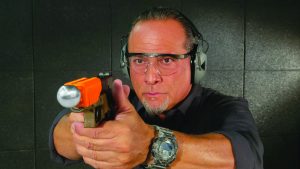
Oftentimes, de-escalation equipment, such as the 40mm and the beanbag shotgun, can be bulky and is generally carried by tactical teams or in patrol cars, which creates limited availability when officers need them. Noticing a critical gap in law enforcement encounters in which an officer responds to a noncompliant subject that presents a threat of violence with a weapon other than a gun, Alternative Ballistics developed The Alternative to provide officers with an option that can always be carried with them and immediately available as a de-escalation tool when the need arises. The two-ounce unit can be carried on a vest, leg holster, or duty belt. “Being able to provide an option—an alternative if you will—for officers to potentially have a step in front of absolute lethal force could be invaluable. Lives could be saved,” said Retired Chief Alex Perez, who is the strategic law enforcement consultant at Alternative Ballistics.
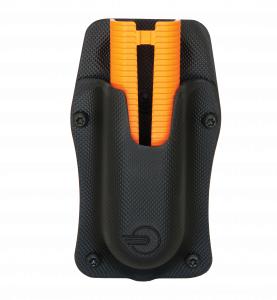
The Alternative temporarily converts a firearm to a less-lethal tool for one shot; once the round is deployed, the unit disengages from the weapon, and the firearm instantly returns to its normal function. This provides an officer with lethal cover without having to transition to and from separate devices.
The unit is composed of two parts: (1) a bright orange dock and (2) an aluminum sphere projectile. The dock mounts to the top of a firearm’s slide and around its muzzle. The projectile (already assembled onto the dock) has retaining pins and is aligned with the barrel of the firearm to catch a bullet. Once fired, the bullet embeds inside the projectile and is carried downrange at 20 percent the velocity of the bullet.
When signing on to use The Alternative, an agency is also signing on to the required one-day training program. The program can be conducted at a specific department or officers can be sent to the Alternative Ballistics facility in Las Vegas. “The training component is as important as the technology we are putting forward,” said Chief Perez.
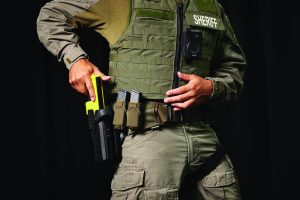
One of the most well-known names in electronic control devices has revamped its less-lethal alternative. In line with its focus to provide safer, more reliable tools to stop threats, Axon has an ongoing commitment to improve upon its products to meet the needs of public safety. This includes TASER energy weapons.
In response to the rise in gun-related deaths during police encounters over the past few years, Axon has accelerated investments to advance their less-lethal technology. The TASER 10 was the first key technology advance following the announcement of the company’s moonshot goal, which is to cut gun-related death between police and the public by 50 percent before 2033. “By disrupting our thinking about how TASER energy weapons should operate and what they should do, we were able to come up with creative ways to give the officer more time and distance to make critical decisions,” said Axon’s head of training, Andy Wrenn. “Most importantly, officers simply needed more chances to stop a threat as soon as possible.”

This is why one of the key improvements to the technology is the ability to deploy up to 10 probes. This is a step up from the previous four probes, which only gave one or two opportunities to be effective. The device also has a tone that differentiates a good connection from a bad connection. When compared to the previous need to deploy two probes simultaneously, individually targeted probes enable a user to create their own spread. These probes now have a range of up to 45 feet, creating more time and space for decision-making. The TASER 10 also features a 1,000-lumen pulsing light, loud audible alerts, and LASER pointing that warns a subject to comply prior to probe deployment.
Wrap Technologies (WRAP) believes in a world where community members openly trust and rely on law enforcement to protect personal safety and well-being. This has allowed them to think beyond less-lethal and strive toward a “no-harm” alternative. This is achieved through the BolaWrap 150.
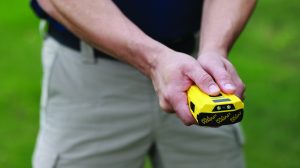
Officers often experience hesitation when considering the use of pain-inducing techniques to restrain individuals. “With the growing scrutiny on the use of force, officers may fear for their careers when resorting to such measures,” said Kevin Mullins, chief executive officer of WRAP. “However, the BolaWrap eliminates this hesitation.”
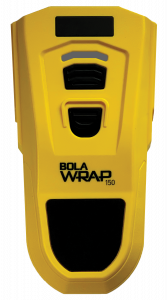
The idea of the BolaWrap started with exploring the use of sound to distract and cause an individual to pause, giving officers time to safely approach and apprehend the individual. When verbal communication is no longer effective, officers can restrain an individual from a safe distance without harming the individual or themselves by using the BolaWrap 150.
The patented handheld remote restraint device deploys a seven and a half foot Kevlar tether to temporarily restrain a subject from distances of 10 to 25 feet. The BolaWrap 150 emits a startling sound upon deploying the tether to distract a subject, allowing officers to quickly restrain an individual and ensure the safety and well-being of everyone involved.
“For situations where physical force would be undesirable or feel excessive… using non-pain compliance techniques can help to defuse tense situations, build trust, and foster more positive outcomes,” said Mullins.
Conclusion
Officers often make situational decisions based on the tools that they have available. “We all have different mindsets and different backgrounds and different ways of processing stimuli put before us,” explained Chief Perez. Using lethal force can affect not only the officer and subject involved but also the subject’s and the officer’s families. Providing less-lethal alternatives to assist during a noncompliant encounter can help save the emotional well-being—and life—of all involved, including the subject, officer, and bystanders.
Officers often make situational decisions based on the tools that they have available.
So, think back to the scenarios mentioned in the beginning of this article and consider one question: which tool is the right tool? With all the options on the market, officers will always have an answer.d
Notes:
1Alex Perez (retired chief of police/strategic law enforcement consultant, Alternative Ballistics) telephone interview, March 30, 2023.
2Andy Wrenn (vice president, head of training, Axon) email interview, April 3, 2023.
3Kevin Mullins (chief executive officer, Wrap Technologies) email interview, April 6, 2023.
|
SOURCE LIST Please click on the companies’ names to go to their websites. |
||
|
|
||
Please cite as:
“Which Tool Is the Right Tool,” Product Feature, Police Chief 90, no. 5 (2023): 56-58.


